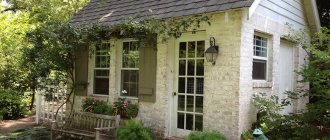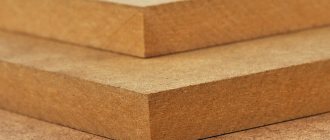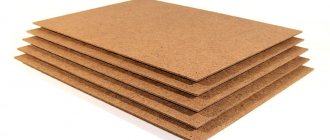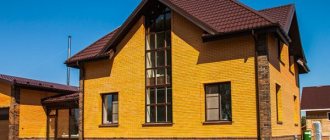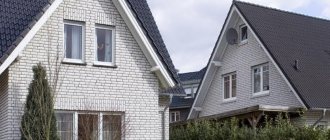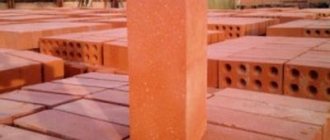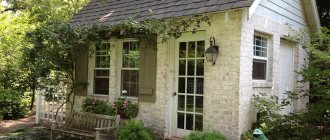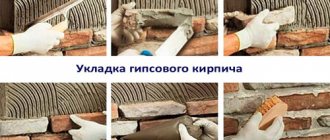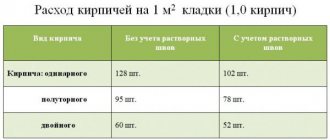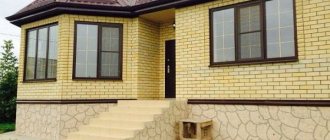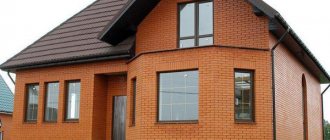Brick is rightfully considered one of the best inventions of mankind - an artificially created stone that has long been used to build houses. Previously, in order to give the facade a beautiful look, artistic masonry techniques were used. Today this process has been greatly simplified thanks to the production of stones with varying degrees of decorativeness. At the same time, the size of the facing brick, its strength and other characteristics meet all the requirements for a regular one, and it differs only in the better quality of the front surface, or the texture or colored decorating layer applied to it.
Facing brick size
Standard sizes
Standardization of brick products makes it much easier to calculate the required material for masonry work, determine the amount of mortar mixture, find out how much a brick weighs and calculate the weight of the masonry. The last indicator is one of the most important characteristics affecting the load-bearing capacity of the building as a whole.
Standard brick sizes Source stroy-podskazka.ru
Table of standard sizes and weights of brick products:
| №№ | Name | Size, mm | Characteristic | Weight, kg |
| 1 | Red ceramic | 250*120*65 | Hollow | 2.3, from 2.6 to 2.7 |
| 2 | 250*120*65 | Full-bodied | From 3.6 to 3.7 | |
| 3 | 250*85*65 | Euro (with voids) | From 2.1 to 2.2 | |
| 4 | Ceramic cladding thickened | 250*120*88 | Hollow | 3.2, from 3.6 to 3.7 |
| 5 | 250*85*88 | Euro (with voids) | From 3.0 to 3.1 | |
| 6 | Silicate | 250*120*65 | Single | From 3 to 3.2 |
| 7 | 250*120*88 | One and a half | From 4 to 4.8 | |
| 8 | 250*120*138 | Double | From 5 to 5.8 | |
| 9 | Clinker facing | 250*120*65 | Full-bodied | 4,2 |
| 10 | 250*90*65 | Hollow | 2,2 | |
| 11 | 250*60*65 | Hollow | 1,7 | |
| 12 | Hand-molded ceramic brick | 188*88*63 | Decorative | 1,9 |
The linear dimensions of brick products may differ slightly from the generally accepted standard. GOST regulates deviation tolerances: in length - up to 4 mm, in width and height - up to 3 mm.
The linear dimensions of the brick may differ Source iz-kirpicha.su
If you are interested in the dimensions of bricks for facing masonry. Notice how the perception of the facade changes with the use of different colors of the masonry joint. How many types of bricks do you see? That's right, one. This is how the same brick looks different when using different colors of Perel masonry mixture.
An example of using different colors of masonry mixture from Perel Source tekato.ru
The facade of your home can give a completely different impression. The effect of combining different colors of facing bricks and colored masonry mixtures opens up space for the most daring design solutions. Colored masonry mixtures from the Tecato company, these are more than 10 colors in the palette under the Perel, Prime and Promix trademarks.
Combining different colors of facing bricks and masonry mixtures Source tekato.ru
See also: Catalog of companies that specialize in the construction of brick houses
How many pieces in a pallet
Products are placed on pallets to simplify the transportation process. Pallets are produced in several sizes and types; accordingly, the number of products that can be placed varies. According to GOST, structures of two sizes should be used: 770x1030, and 520x1030 mm. When purchasing, it is better to personally count the number of stones on the pallet. Quickly calculate the quantity like this:
- determine the number in a row;
- recalculate the number of rows;
- multiply the resulting values by each other.
The weight of a pallet of facing bricks also depends on the number of materials laid on it. Permissible load – 1.5 tons. The manufacturer always reflects the exact weight, since the choice of transport for transporting cargo depends on it.
Data is provided on the number of products of different parameters that manufacturers usually put on a pallet
For cladding, as well as for building a house, it is better to buy 5% more material. The process may be damaged or defective.
Classification of bricks by composition
For the production of bricks, a variety of raw materials are used, which determine the scope of its application and dimensional characteristics. The following types of brick products are widely used in residential and industrial construction:
- Red ceramic , made from red clay or its varieties by firing.
- White silicate , consisting of lime and sand with the addition of various additives that determine the color of the brick.
- Facing . This type is made from a certain type of clay by firing in ovens at a temperature of 1000 to 1200 degrees. In the production of facing bricks, hyperpressing technology is used and therefore this type of brick product is often called hyperpressed brick.
- Clinker , made from a mixture of refractory types of fireclay clay, feldspars and clay materials. Clinker is formed as a result of flowing in kilns with a temperature of 1200 degrees.
Clinker brick is a type of facing ceramic products. Source pinterest.com
Decoration methods
There are many ways to decorate the front surface, for example, relief designs imitating leather, fabric, etc. Aged, vintage walls are in fashion - picturesque cracks, as if areas of masonry have been weathered or washed out by rain.
The front surfaces are shotcrete - a layer of glass chips, sand, porcelain flour, etc. is applied under pressure. Before firing, engobe can be applied to the raw material - liquid white or colored clay, which after the oven turns into a coating of high decorative quality.
This can be done by glazing, applying polymer coatings - there are many design options. But even for such products, the standard that determines the size of facing bricks applies. What is important is to maintain a strong bandage, reliable connection between the facing layer and the main structure of the wall - all this is the key to the durability of the building.
Red brick
If we conduct a kind of rating of popular types of brick products, of course, the first place of the leader would belong to red ceramic brick, as the most famous and sought-after building material with a wide range of applications in the construction industry. Red brick is classified by size: single, one-and-a-half and double. To better understand the differences in brick size, we suggest taking a closer look at the material characteristics that underlie the classification of ceramic red brick.
Wall made of single red ceramic brick Source kirpichnii-dom.ru
According to existing standards, the size of a red brick is 250 mm in length, 125 mm in width and 65 mm in height. Brick products of this standard size are ideal for interlocking brickwork. In construction, solid bricks weighing up to 3.6 kg and lightweight products with voids, weighing from 2.3 to 2.7 kg, are used.
The side surfaces of the brick have their own names:
- “Bed” is the working side of the product with the largest area. In bricklaying, the brick is laid on a bed.
- “Spoon” is the side of the brick, its middle part.
- “Poke” is the back part, the narrowest in width.
Poke, spoon and bed of bricks Source postroi-ka.by
A red single brick of normal size may differ slightly from the approved standards: deviations in length are allowed up to 5 mm, in width -4 mm, and in height the permissible deviation is up to 3 mm.
One-and-a-half red ceramic brick Source stroymig64.ru
Private and front
Artificial stones for the bulk of erected walls now look so that it is impossible to talk about them as bricks. Ordinary, or, as it is called, simply building brick loses its relevance if its size is the same as the standard size of the facing brick. Multi-hollow or porous stones replace several pieces of ordinary bricks in volume, but weigh significantly less.
A brick classified by the manufacturer as a facing brick with a smooth surface must have at least two front faces (most often these are a poke and a spoon). This means that they have no chips, cracks or foreign inclusions, they are uniform in color.
Sand-lime brick
White sand-lime brick is on the second step in the ranking of popular ceramic products. To create it, silicates are used: lime, quartz sand, as well as plasticizing additives. Silicate brick products are produced by pressing and further processing with water vapor in special autoclaves.
Sand-lime hollow brick Source orsha.zakup.by
The material is classified by size:
- Single . The standard size of sand-lime brick of this class is 250x120x65 mm. Usually they are produced only solid, without voids.
- One and a half . This type of brick has linear dimensions that differ from single bricks in height and its standard is 250x120x88 mm, the weight of the brick is from 4 to 4.3 kg. One and a half silicate brick is considered the most popular material from the entire group of silicates. To reduce the overall weight of the masonry, one-and-a-half products with voids of various shapes are produced. The laying of load-bearing brick structures is carried out only from solid products.
- Double . The standard size of this class of silicates is 250x120x138 mm and is twice the height of a single silicate. Most often, for ease of use, such bricks are produced in hollow form.
Wall made of sand-lime brick Source stolyarka-mos.ru
The scope of application of sand-lime brick has limitations: it is not used for laying walls located below the zero level of a building or structure. This is due to the fact that silicates, due to their high water absorption coefficient, upon contact with a humid environment, can collapse and lose their strength.
Dimensions of different types
There are these types of material:
- ceramic;
- clinker;
- hyper-pressed;
- silicate.
Dimensions may vary depending on the type of product.
Standard dimensions of material according to GOST
Ceramic
The dimensions of facing ceramic bricks are standard. The structure of the finished stone is homogeneous or with voids. It is breathable and moisture resistant.
Its advantages include:
- soundproofing properties;
- withstands strong temperature fluctuations;
- fire safety;
- resistance to loads;
- ease of installation.
The finished product has a uniform color. There are no cracks or chips on the surface. A popular color used for decoration is yellow and its shades. The sizes of yellow facing bricks are standard and do not differ from the others.
Disadvantages include:
- high price;
- the material becomes brittle due to violation of production technology.
Clinker
Clinker brick has high strength properties. Made from special clay, the product is molded and fired at elevated temperatures. The finished material comes with internal hollow holes and solid.
Advantages:
- does not fade;
- moisture resistant;
- thermal insulation properties;
- resistance to constant temperature fluctuations;
- mechanical strength;
- long service life.
Due to its strength properties, the material is widely used in construction. It is used for: courtyards, doorways, basements, paths near a pond or pool. The most commonly used colors are red and beige for decoration. The dimensions of facing red brick are standard 250x85x65 mm, thin 250x60x65 mm are also used.
The disadvantages include:
- does not absorb water.
- weight.
- price.
Standard dimensions of clinker products are 240x115x71 mm. Installation is a rather labor-intensive process and requires additional skills and auxiliary materials; it is better to entrust this work to specialists.
Hyper-pressed
Hyper-pressed bricks are produced through the process of semi-dry hyper-pressing. The product is made from environmentally friendly materials such as shell rock and limestone. Dyes are added during production, resulting in products with a wide range of colors. The finished product has a non-standard relief.
Advantages of the material:
- exact dimensions;
- frost-resistant.
This material is often used for cladding both single-story and multi-story buildings.
Flaws:
- cracks appear under the influence of temperature;
- fades when exposed to sunlight;
- weight.
Standard parameters of finished products are 250×120×65.
Silicate
Sand-lime facing brick is produced through the pressing process. For production they use: sand, limestone and water. The proportions of the composition are carefully observed; due to their violation, low-quality materials are obtained.
Advantages of the material:
- ecologically pure;
- soundproofing properties;
- price;
- simple installation process.
Finished products have clear geometric parameters. Sand-lime facing brick is frost-resistant and is used for both internal and external finishing work.
Disadvantages include:
- moisture permeability;
- thermal conductivity;
- weight.
Also, this brick has a small palette of colors, in which it is inferior to other types. Dimensions depend on the type. Standard parameters 250×120×65.
Concrete facing brick
To make concrete bricks you need: granite screenings, cement and water. The ingredients are mixed and shaped, then left to harden. Due to the ease of production, the cost of finished products is low.
Standard dimensions: 250x60x65 mm, 250x90x65, 250x120x65 mm. Manufacturers can also produce products with other parameters.
The advantages include:
- price;
- ease of installation;
Concrete facing brick has high strength characteristics and is resistant to the external environment.
Flaws:
- cracks occur if the production technology was poorly followed;
- weight.
The material is not inferior in its strength qualities to other types. It has a large palette of colors from bright to pastel and looks good on facades.
Combined brick
One of the most unusual and popular types is combined brick. It has good strength properties and is resistant to external factors. The cost of this material is high.
This type has a difference in texture and color, the most common of which are wood or metal. It embodies several types of bricks at once. It is used for external and internal work. Most often used for: building facades, decorating fences and stairs, flower beds, borders on paths.
Handmade brick
The production of handmade bricks is mainly carried out by European companies. This material comes in many colors and different sizes. The manufacturer can “control” the properties of the material and, using the composition, set the necessary parameters. The cost of such products is high. Each batch is produced in limited quantities.
Most often used for restoration work. Used for ancient castles, churches, chapels.
Figured (shaped) brick
One of the most popular types is figured brick. Finished products have different shapes and dimensions. The range of colors is also wide. With the advent of shaped bricks, builders no longer need to hew and cut elements of a suitable size and shape from ordinary rectangular bricks. Thanks to such products, any building can be decorated in an unusual and elegant way. This material is convenient for finishing columns, pillars, door and window openings.
The cost of shaped products is higher than regular rectangular ones. This is due to production costs.
How to properly care for a facade with a facing brick surface?
The aesthetics of an external wall made of facing bricks can be spoiled by efflorescence - large whitish spots. Their occurrence can be avoided through measures taken at the stages of construction work and during operation:
- When carrying out masonry work, use non-additive Portland cement.
- Eliminate the presence of water-soluble salts in fine aggregate (sand) and water.
- When laying bricks with low water absorption, use only rigid masonry mortars.
- Work at positive temperatures, since the use of antifreeze additives is undesirable. Freezing of masonry is prohibited.
- Prevent masonry mortar from getting on the front surface of the blocks.
- After completing masonry work, cover the masonry with waterproof film every day.
If efflorescence does appear, you cannot wash it off with water or wipe it with a dry cloth. For this purpose, it is necessary to purchase a special composition that will not only remove existing efflorescence, but also prevent its further appearance.
